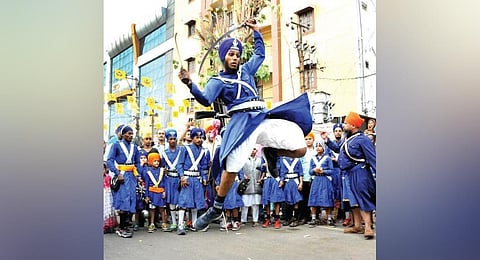

HYDERABAD: Vaisakhi, largely known as a festival of spring harvest in North India, and celebrated in mid-April, holds great significance for the Sikh community as it comemorates the birth of ‘Khalsa’. The tenth guru, Guru Gobind Singh established Khalsa panth to spread the idea that “no ritual is above the almighty and one should not fall for any superstition,” says Sajjan Singh, a Hyderabadi and a member of committee for heritage preservation and conservation, SGPC Amritsar.
“To give Sikhs a distinct identity, Guru Gobind Singh reconstituted Sikh community as ‘Khalsa Panth’ on 30th March, 1699 at Anandpur Saheb in Punjab,” said Sajjan Singh. “His declaration had three dimensions: it redefined the concept of authority within the Sikh community, introduced a new initiation ceremony and code of conduct; and provided the community with a new religious and political vision,” he added.
The new initiation rite was called ‘Kande ki Pahul’ (ceremony of the double-edge sword). The revealed ‘word’ was recited while water for initiation was stirred with a double-edge sword. Every Sikh who underwent the ceremony became a member of Khalsa, and was assigned the name ‘Singh’ or ‘Lion’, and was expected to observe a rigorous code of conduct (rahit) symbolized by wearing of five items : Kes (long hairs), Kanga (a comb), Kacha ( shorts/undergarment), Karha (a steel bracelet) and Kirpan (a sword).
Retelling the story of the ‘Panj Pyaare’, or the five beloved ones, Sajjan Singh says, “Guru Gobind Rai asked his followers to come to Anandpur Saheb and not to cut any of their hair –to come with unshorn hair under their turbans and chunis, and for men to come with full beards. On 30 March 1699, thousands of people gathered around the temporal seat of Anandpur Saheb. The Guru addressed the congregation with a stirring oration and said that every great deed was preceded by equally great sacrifice, and then demanded one head for oblation. After some trepidation one person offered himself for the Guru’s ‘great sacrifice’. The Guru took him inside the tent.
A little later Guru came out of the tent, his sword dripping with fresh blood, only to ask for another head. One by one four more earnest devotees offered their heads. Every time the Guru took a person inside the tent, he came out with his sword dripping fresh blood. Thinking their Guru had gone mad and afraid that he would ask for more heads, some of the congregation started to disperse. Then, suddenly the Guru emerged with all five men dressed piously in white.”
The Guru initiated the five into a new and unique order of Sikhs. The ceremony was called Pahul, which is baptism day or ‘Khalsa formation Day’. “The Guru proclaimed that the Panj Pyare –the five beloved ones- would be the embodiment of Guru himself: ‘Where there are Panj Pyare, there am I. When the Five meet, they are the holiest of the holy’. Guru Gobind Rai himself got baptised from them and was rechristened as Guru Gobind Singh. The ceremony of Pahul continues to this day,” said Singh.
“Among the first Panj Pyare, there was Bhai Daya Singh ji from Lahore, second was Dharam Singh ji from Hastinapur, Bhai Himmat Singh ji from Jagannathpuri, Bhai Muhkam Singh ji from Dwarka and Bhai Sahib Singh ji from Bidar,” he added.